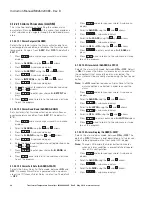
14
Instruction Manual IM02602008E - Rev. D
Transformer Temperature Controllers
IM02602008E - Rev. D May 2019 www.eaton.com
4. Operating Procedures
NOTICE
FUNCTIONS DESCRIBED IN THIS SECTION ARE THE
SAME FOR ALL MODELS, UNLESS OTHERWISE STATED
IN A SUBJECT HEADING.
TC models can be operated/programmed three different
ways::
•
Manual Operation,
using the front panel controls (all
models)
•
Local Operation,
using a laptop computer connected to
the TC USB port (all models
)
•
Remote Operation,
using a standard Modbus communi-
cations network (TC-50 Modbus and TC-100 only).
Regardless of the operating method selected, each TC must
be set up or programmed to best suit the needs/desires of
the user.
The Reset and Test functions are only available in Manual
Operation using the front panel controls.
The programming functions of all TC models are the same,
regardless of the operating method used.
However, each operating method varies in its execution. For
this reason, each is described in a separate section, below.
4.1 Manual Operation
Operating the TC models manually, at the front panel,
requires a thorough understanding of the controls and
how they are used to set up/program the controller. These
controls are used to set up various operating parameters,
change setpoints, reset alarm and trip relays, and clear data
logs used for reports.
Some functions of the TC can be controlled manually by the
operator, such as turning the cooling fans On or Off, silenc-
ing alarms, and performing various test routines.
The content of this section is organized into four functional
areas:
•
Control Functions
•
Reset Functions
•
Programming Functions
•
Test Functions.
4.1.1 Control Functions
The front panel contains one 8-charcter LED display, nine
discrete LEDs, and nine pushbutton membrane switches.
Using the front panel controls, the user can set the TC for
automatic operation, establish setpoints, configure the sys-
tem, and set operating parameters.
The bottom of the front panel also contains one flip-up door,
which can be sealed with a locking wire, that covers a USB
2.0 port. The USB port is used to connect a laptop computer
to the TC to operate it
Locally
.
The front control panel layout is shown below, in Figure 12,
TC - Front Panel Controls.
The function of each front panel control is explained on the
following pages.
Figure 12, TC- Front Panel Controls
















































